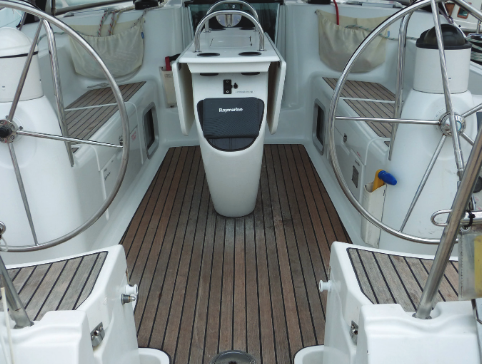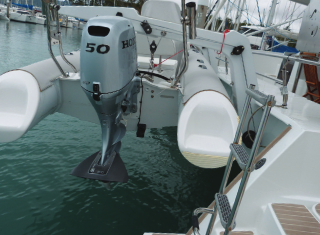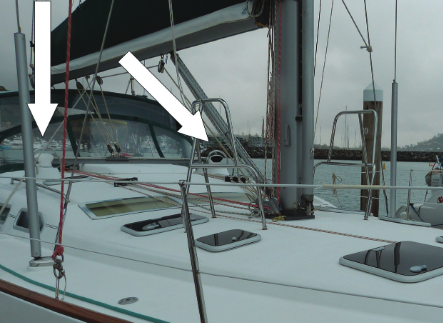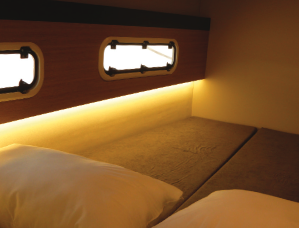Industry professional Petrea McCarthy spotlights the knowledge and highlights the pitfalls to look out for before ordering your dream boat.
Working on a variety of current-model production yachts has shown me aspects of them that few people get to see. These are the same boats tested in magazines like Cruising Helmsman and advertised as being of excellent quality, practicality and value.
I also work on older Australian production boats and have done so for about forty years. In this article, I will share some of the insights I have gained and ways you can avoid disappointment and costly mistakes.
If you are thinking of buying a new boat, remember to look beyond the sales talk. Think seriously about future additions and consider having the boat surveyed upon delivery.
A multitude of potential problems awaits discovery. I am not talking about the obvious things mentioned in boat reviews, but those hidden but significant details that can totally change a boat’s cost or safety status.
Boat reviews by nature are short and only cover the basics. The reviewer gets to sail the boat in company with the salespeople, for a couple of hours in sheltered water. It is a huge call on their experience to evaluate a boat under these conditions.
These days almost all production boats sail competently. Ultimate speed and pointing ability are irrelevant for cruising, compared to handling, comfort and sea keeping qualities. Yet testing is rarely carried out at sea.

As a group, the newer imported boats are lighter, faster, more spacious and offer vastly more convenience than older designs. With some notable exceptions, they are sleek and inviting. However, beneath the veneer of quality can lurk some interesting short cuts. The lack of foresight by the builders of these boats often frustrates all of us who work on them.
What could possibly go wrong?
Foremost amongst these frustrations is the difficulty of adding to the as-delivered specification. We spent hours on a European monohull trying to find a way to bolt some new fittings to the deck. To gain access under the side decks we would have needed to cut away part of the fibreglass interior moulding.
Alongside the cockpit, a moulded lining on one side and a large tank on the other totally prevented access to the underside of the deck. Further aft, we could see the underside of the deck, but it was inaccessible to any size adult. Perhaps we needed a small, trained monkey.
One new boat I worked on had its headlining glued in place. How do you remove this when access is required? With a knife. Why was access required? To add some hardware so the reefing lines and headsail halyard could actually be led to a winch. Could you tension a halyard and reefing lines on a 16-metre boat by hand? Neither could the owner. The electrician also needed access to run some new wiring.
Another boat, from a respected UK builder, had a dedicated space in its engine room for a generator. To get the generator in the wheelhouse, furniture had to be dismantled because it was built over the access hatch. I mean dismantle with a saw. It was not designed to be taken apart. That boat also came with rubber gaskets on its fuel tanks. As you probably know, rubber and diesel are not compatible.
At least the gaskets were visible. When they leaked it was relatively simple to change to cork gaskets, but you have to wonder what the person who fitted them was thinking. Gasketed fuel tank openings enable access for cleaning. So why did one Asian builder construct the cabin sole millimetres above the tanks?

A routine inspection while the boat was under construction saved the owner tens of thousands of dollars. The surveyor insisted the tank tops be made accessible. Without taking the owner’s cabin apart.
As well as silly features seemingly stemming from ignorance, we have regrettable, but conscious choices made for the sake of appearance. The davits on some catamarans have the sheaves for the lifting lines cleverly concealed within the tubular davit. Fine, except the exit slot in the stainless steel has no protection for the rope. A perfect rope-chewing machine.
At least those davits lift the dinghy clear of the sea, unlike many others. Some davits are deliberately set low to enhance the streamlining of the boat but simply cannot raise the dinghy high enough. Most also lack any provision for holding the dinghy in place on the davits, leaving it free to swing from side to side unless restrained by jury-rigged lines.
You need to look beyond the obvious things and not make assumptions. Can the sails be reefed? I am not kidding; I have worked on seven-figure boats on which the reefing lines and the halyards could not be led to a winch. Can extra sails be stowed aboard? One luxury cat I worked on, despite being over fifteen metres long, had nowhere to stow the screecher when it was not in use. There was no locker big enough to store it, so when not hoisted it had to be taken ashore.
Let us go below. Is the ventilation adequate for the intended cruising area? I saw one cat with seven cabins, each with only a single 30-centimetre square ventilation hatch. The vast bridge deck area had only two small vertical windows forward and sliding doors aft to let air circulate. No overhead hatches, no all-weather ventilators, no other openings. Many production boats do have decent hatches over each cabin, but what if it rains, or when spray is flying.
Three, four or even seven cabins could mean a lot of people showering, a lot of food preparation and washing up and a fair bit of water consumed for drinking. How long will the fresh water last? Do the toilets use fresh or seawater for flushing?
One way to overcome calcification and odour in toilet plumbing is to eliminate salt water. To avoid this recurring hassle, some toilets flush with fresh water. You could install a water maker to ensure a plentiful supply. Is there room for one? Can you add this and other options like generators and electronics without blocking in other gear that you may need to remove some day?
The majority of shortcuts are not taken to deceive the buyer but to keep prices competitive. By default, the details percolate down to the lowest common denominator. A builder who is not cost effective soon ceases to build in the mass market. The fact is that you do not necessarily get what you pay for. Even expensive models can have built-in issues that will cause trouble eventually.Some shortcuts are just bad workmanship. On one new French boat, we took hours to remove a few fittings from the aluminium davits.
The seized stainless fastenings were minus any shred of anti-corrosion compound. A basic precaution when using dissimilar metals had been overlooked. Unfortunately, this caused the otherwise flawless paint to bubble around the fittings.
Another job was to fit some extra blocks to a mast base: a simple process of inserting a nut into a cavity and attaching a bolt. However, the mast base was set in a generous bed of silicone that had squeezed into every available cavity. Digging it out took an hour per hole. Covering the holes when applying the silicone would have prevented the problem. Extra time? Maybe two minutes.
We also found, when adding another sheet winch to the same boat, the existing winch bolted to the balsa core without backing plates. Eventually this will crush the balsa. The fastenings will loosen and, at best, leak, letting moisture into the core. On a production run it is simple to insert backing plates or revert to solid fibreglass where hardware will be fitted and in places where extras may reasonably be anticipated. When adding fittings on older boats it is not unusual to find backing plates already installed.
A recent ploy I saw was on a new high-end boat with an international-brand rig. Its no-name el cheapo furler was a crude copy of a well-known brand. The boat arrived after its delivery voyage with this furler damaged. Parts were not available because no one could identify the furler. Incorrect installation caused the initial problem and then careless handling compounded it.
Another new boat arrived fresh from a boat show with the headsail halyard only knotted where it attached to the furler swivel. Someone forgot the splice. Not surprisingly, the halyard had broken.
I have not even mentioned my perennial question: where do you store a dinghy? On most production monos, you cannot. Who is going to haul an inflatable aboard each night, take off its outboard and stow it away in a locker? We might hoist it with a spare halyard and let it lie along the mother ship’s topsides if the anchorage is calm, but it still needs dedicated space on deck where it can be stowed when sailing.
There are many less serious issues, which are not necessarily recurring. Boats arrive with pink or yellow ‘white’ gelcoat, screw ends protruding into lockers, plumbing leaks and other relatively minor problems. How can a potential buyer know any of these things? Mistakes like rubber gaskets on fuel tanks are only found when the tanks begin to leak, but a qualified surveyor may pick up faults and short cuts.
If you are spending those sorts of dollars, a detailed survey could save far more that the cost of fixing a problem when it goes wrong. Another source of information is online forums where model-specific issues often come to light.


A to Z of boat checking
Now a few things you should consider before plonking down the dollars.
• Advice: check the forums, charter the boat you are interested in, look at three- to four-year-old models of the same boat, ask owners about any difficulties.
• Adding fittings: is there access under the deck, or will you need to remove furniture, or cut the headlining?
• Anchoring: on a catamaran does the windlass gypsy hold more than two to three links of chain? Chain needs to turn at least ninety degrees to get a proper grip on the gypsy. Many anchor-winch installations do not allow enough fall for the chain, leading to the chain jumping on the gypsy and piling up in the anchor locker. How much chain and what type of anchor are included.
High holding power anchors have proven superior to older types, so do not settle for a last-century anchor on a new boat. You will need more than one anchor, but that is just one of the many additions you will make to turn your production boat into a capable cruiser.
• Batteries: are they big enough, numerous enough and is there room to add more?
• Boarding: most modern boats have excellent boarding platforms on the transom(s), but if the boat is alongside or in a berth bow first, how do you get aboard? Some boats have such high freeboard that the traditional milk crate and lifeline gate is inadequate. At least one popular brand of cat has toeholds moulded into the topsides to allow side access. Do you really want to have to climb these? Can you and your crew manage this?
• Cabins: often look roomy, but is there space for clothes stowage, can you enter and exit without acrobatics and is there enough headroom over the berth? It does depend on what you plan to do in there, but even the most chaste will feel claustrophobic if the deck head is too close above the mattress.
Are the bunks long enough? V-berths are often too narrow forward. Will the ventilation work in inclement weather? Are the berths practical at sea, in a rolly anchorage, or in hot weather? Does the boat actually have any sea berths? Even if you only plan on day sailing, someone may want to lie down, and you may occasionally need to sail overnight.
• Cockpit: can you reach the bottom of the lockers? If not, is there provision for getting into them? Is there a way to secure and separate gear stored inside? Stacking everything in does not work because whatever you need will inevitably be under everything else. Is there room for a portable generator, water maker or spare sails?
Are the cockpit coamings comfortable to lean against, even when the boat heels? Where will you brace your feet? A wide cockpit may have a permanent central table. Is it strong enough to take the force of someone falling on it? Can you comfortably stand at the helm? What about visibility, many boats have so many obstructions it is not possible to see forward from the helm.
This is especially important if the boat has a connecting piece between the bimini and dodger. That little strip of canvas may be right in your line of sight. If you are short, ensure you can see over the binnacle-mounted instrument pod.
• Davits: do they lift the dinghy clear of the sea, even when the boat heels? Does it hold the dinghy securely athwartships? Are they strong enough to withstand a breaking wave? A dinghy full of water, even if only for a moment, puts a huge strain on davits and their mounting points.
• Deck drainage: are the scuppers at the low points? Decks should slope in relation to the designed waterline and athwartships. Ditto cockpit seats. Some production boats must be exactly level for water to drain off the seats. In practice, the boat will seldom be exactly level.
• Desalinator: needs an accessible location. You will need to adjust taps and check gauges. What about access for plumbing from the seaside to the wastewater and to the water tanks?
• Dinghy: if not in davits, how do you carry it? Can you fit davits without obstructing access through the transom? Where will the outboard stow? How will you get the outboard into and out of the dinghy? Ditto its fuel tank and spare fuel. If you want a motor large enough to plane the dinghy, can you heft it aboard or does it need a small crane?
• Engine: luckily most production boats come standard with a more than adequate engine, unlike earlier times when a size upgrade was often desirable. You will need access to the fuel and oil filters, dipstick and shaft, as well as to any bolted-on accessories. If this requires removal of the companionway steps, where do you put them? Does the boat have a hinged arrangement to allow lifting the steps or sliding them sideways, or will the whole panel/step assembly be completely loose? This could be dangerous in a seaway.
• Fuel tanks: can you get to the tops to remove the covers and clean them out, without disassembling the engine room?
• Floorboards: usually the lifting handles also lock the boards in place. If there are no lifting handles, what holds the boards in place? Some production boats do not have the floorboards secured at all.
• Galley: many galleys look lovely but lack space for pots, a cutlery drawer and bench space for food preparation. Even if you prepare meals using the covered sink or stove for bench space, where do you put the various bits when the stove is in use? Can you reach right into the fridges? Do they have dividers and shelves to separate the contents? You may admire that deep sink, but is it too low for you to wash up in? Is the bench height practical for the person who will be using it?
• Genset: will you want a generator? Built in or portable? Where will it fit? Does the engine room have space where it will be accessible but not block access to something else? Where will its fuel supply come from?
• Handling: twin rudders are fashionable on monohulls but contribute to handling problems at low speed. Boats on which the rudder receives the prop wash are easier to manoeuvre.
• Headlining: is it removable?
• Helm: can you see over any instruments mounted there; on a cat can you see forward at all? Is the wheel height okay for short and tall drivers? Holding a wheel at chest height can be very tiring, as can bending down to it. Especially on boats with through-transom access, is it easy to pass the steering wheel?
• Interior: check for cheap veneers, poorly fitting locker doors, rough finish inside lockers and provision of lights and handholds. Squared-off corners may look edgy and 21st century but are impractical even in a house.
• Keel connection: how is the keel attached to the hull? Fin-keel boats using a ‘matrix’ to spread the keel loads have lost their keel after the matrix sustains damage from grounding. Damage is difficult to assess and expensive to repair. You are buying a new boat that has not yet run aground, but in time you will have a boat that has suffered a few groundings.
Depending on design and build quality, it may be you who needs to find someone who can to assess the damage, if any, and restore it to as-new strength. Remember that the stories of complete failure, where the keel actually fell off, are the extreme. How many boats are sailing around damaged, but with no outward sign of that damage? Although fallible, one reassurance is if your boat can stand on its keel.
Some companies recommend against this – a red flag for a cruising boat, which may need to haul out away from its home port. I agree with frequent CH contributor John Tylor that a cruising boat should be able to take grounding without damage. Investigate the history of both fatal and non-fatal keel loss for the brand you are considering (see pullquote).
• Layout: how much does the interior layout compromise the primary function of the boat: to sail? Many production yachts have very poor weight distribution with large tanks under the v-berth or cockpit. Boat trim changes considerably when those tanks are filled or emptied. They also add weight in the ends, which is detrimental to both speed and motion.
• Performance: is the rig compatible with the hull? Square-top mainsails may add sail area, but they are difficult to handle compared to shapes that are more conservative. A flash mainsail is not going to turbo-charge a cruising cat with fixed, low-aspect keels. Likewise, a cruising monohull does not usually need a tall, complex rig.
• Power: is the boat dependent on electricity? Can you add capacity with more batteries, solar panels or wind generators? Electric winches and cook-tops need reliable energy and lots of it.
• Rig: production boat rigs are pretty standardised and conservative, but far too complicated. Check that you are getting brand name rigging with genuine, branded components. If you are buying towards the performance end of the spectrum, think about ongoing expenses. Compact-strand (Dyform) rigging offers 30 per cent more strength than 1×19, but costs about twice as much to replace.
Sure, you can go up a size, but the fittings may not be compatible with larger diameter wire. I have even seen production boats with rod rigging, which insurance companies usually want replaced far more regularly than wire. Check accessibility of the chainplates. Will they be accessible if/when they leak, without dismantling interior furniture?
• Safety: does the boat have emergency bilge pumps in the major compartments? If not, can you fit them and run their discharge hoses to a seacock? Be aware that the European Community’s Recreational Craft Directive only requires through-hull fittings to last five years. British marine surveyors have found a disturbing number of yachts with seacocks of ordinary brass, rather than bronze or glass fibre reinforced nylon.
• Sails: will probably be low-tech and mass-produced, which is fine if the quality is good.
• Sail handling: are the systems practical or awkward. Do all necessary lines lead to winches? Is everything you want to adjust accessible? If the boom is above head height, how are you going to attach the main halyard and get the sail down? Standing on a step on one leg, one arm wrapped round the mast, while trying to attach a shackle with the other is neither fun nor safe. If steps are needed, make sure there is a pair of them at a convenient height to stand on.
• Solar panels: is there room to fit them where they will not be in the shadow of the boom or deck structures, or where they will be stepped on?
• Steering gear: is the quadrant and steering cables below deck protected from gear stored in the same area? If not, can it be separated so you do not end up with mooring lines or other paraphernalia jamming the steering?
• Stowage: besides food and drink, you will need to stow bedding, wet weather gear, spares, first aid gear, safety gear, a liferaft if you are sailing in open water and enough clothes for the trip you are planning. Many cabins look spacious because they lack shelves and lockers.
• Tankage: is there enough water for the expected crew, showers, and washing machine. Diesel fuel usage is approximately one litre per cylinder per hour, so you can make a rough estimate how far you will get on each tank.
• Toilets: unless it has a freshwater flush, eventually the hoses will begin to smell. Is it all accessible? Ditto the macerator, because inevitably someone will flush something that should not be in there. Where is the holding tank? At least one production model has it shoehorned into the engine compartment, blocking access to the motor. Some are under the bed, a situation I would rather not encounter.
• Ventilation: hatches, ventilators that can stay open in rain and spray, suitable for where you are. Anyone with some sailing experience can make a checklist from the ideas above. If you are new to sailing, you can really only evaluate any boat superficially. I strongly recommend consulting an experienced yacht surveyor, first. They should be able to guide, or at least inform your choices and point out advantages and deficiencies of a boat.
Am I saying that all imported production boats will have these problems? Not at all. Yours may have only a few issues, or none. The dealer will probably have them rectified in the warranty period. I am saying that mistakes are made, and shortcuts taken in the interest of economy. Your new boat may be perfectly satisfactory. The chances of that happening can only increase if you are aware of what can go wrong.
Petrea, the longtime editor of Cruising Helmsman’s Ideas Locker, is rigger and former long-term live-aboard cruising skipper. A coastal cruiser at heart, Petrea has also sailed the SW Pacific and Tasman Sea. She has competed in all major east coast ocean races and currently works as a rigger for Quadrant Marine at Airlie Beach.

























